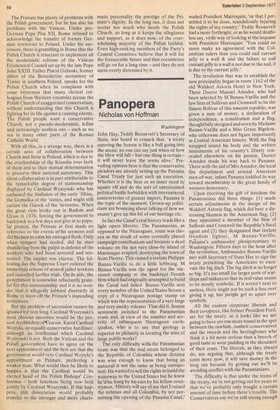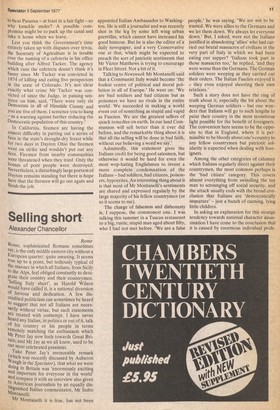Panopera
Nicholas von Hoffman
Washington John Hay, Teddy Roosevelt's Secretary of State, was heard to remark that, 'a treaty entering the Senate is like a bull going into the arena: no one can say just when or how the blow will fall — but one thing is certain — it will never leave the arena alive.' Prevailing opinion here is that the conservative picadors are already setting up the Panama Canal Treaty for just such an execution. Whether it is the heat or an inner need to square off and do the sort of unrestrained political battle forbidden with international controversies of greater import, Panama is the topic of the moment. Grown-up politicians are bouncing about talking of how we mustn't give up this bit of our heritage etc.
In fact the Canal's real history reads like a light opera libretto. The Panamanian, as opposed to the Nicaraguan, route was chosen as the result of some correctly placed campaign contributions and because a dead volcano on the not very close-by island of Martinique erupted, destroying the town of Saint Pierrre. This caused a certain Philippe Bunau-Varilla to do a little lobbying. M Bunau-Varilla was the agent for the successor company to the bankrupt French firm which had originally attempted to build the Canal and failed. Bunau-Varilla sent every member of the United States Senate a copy of a Nicaraguan postage stamp on which was the representation of a very large and very smoky volcano. That did it. Senate sentiment switched to the Panamanian route and, in view of the number and severity of subsequent Nicaraguan earthquakes, who is to say that geology is superior to philately in locating the sites of large public works?
The only difficulty with the Panamanian route was that the real estate belonged to the Republic of Colombia whose dictator was wise enough to know that being an autocrat is not the same as being omnipotent. He wanted to sell the rights to build the waterway to the United States but he knew he'd be hung by his ears by his fellow countrymen. 'History will say of me that! ruined the isthmus and all Colombia, by not permitting the opening of the Panama Canal,' wailed President Marroquin, 'or that I permitted it to be done, scandalously injuring the rights of my country.' Teddy Roosevelt had a more forthright, or as he would doubtless say, virile way of looking at the impasse with President Marroquin: 'You could no more make an agreement with the Colombian rulers than you could nail currant jelly to a wall & and the failure to nail currant jelly to a wall is not due to the nail, it is due to the currant jelly.'
The revolution that was tO establish the new principality began in room 1162 of the old Waldorf Astoria Hotel in New York. There Doctor Manuel Amador, who had been selected by M Bunau-Varilla and the law firm of Sullivan and Cromwell to be the Simon Bolivar of this nascent republic, was given a sum of money, a declaration of independence, a constitution and a flag, thoughtfully designed and sewn by Madame Bunau-Varilla and a Miss Grace Bigelow, who otherwise does not figure importantly in Central American history. With the flag wrapped round his body and the written instruments of his country's liberty concealed elsewhere on his person, Doctor Amador made his way back to Panama. There with the aid of Mrs Amador, the local fire department and several American men-of-war, infant Panama toddled its way toward membership in the great family of western democracy.
Upon receiving the gift of freedom the Panamanians did three things: (1) made certain adjustments in the design of the Waldorf Astoria flag, which did bear a distressing likeness to the American flag; (2) they appointed a member of the firm of Sullivan and Cromwell the Republic's fiscal agent and (3) they designated that tireless freedom fighter, M Bunau-Varilla, Pa;iama's ambassador plenipotentiary to Washington. Fifteen days to the hour after the revolution, Ambassador Bunau-Varilla met with Secretary of State Hay to sign the treaty permitting the Americans to excavate the big ditch. The big ditch is no longer so big. It's too small for larger sorts of warships and tankers so that its real value seems to be mostly symbolic. If it weren't next to useless, there might not be such a fuss over giving it up, but people get so upset over symbols. All the eastern corporate liberals and their co-optees, like former President Ford, are for the treaty, so it looks like we are going to have yet one more round in the spat between the rawhide, sunbelt conservatives and the tweeds and the herringbones who think it a bit more serious than a breech of good taste to wear padding in the shoulders of their coats. The liberals, as they always do, are arguing that, although the treaty costs more now, it will save money in the long run because by getting out we'll be avoiding conflict with the Panamanians.
The difficulty is that under the terms of the treaty, we're not getting out for years so that we've probably only bought a certain amount of time before there's trouble. The Conservatives say we're still strong enough to beat Panama — at least in a fair fight — so Why knuckle under? A possible compromise might be to pack up the canal and take it home when we leave.
Lest you think the Government's time entirely taken up with disputes over trivia, the Secretary of Agriculture is in trouble over the naming of a cafeteria in his office building after Alfred Tacker. The agency Which runs the cafeteria doesn't think it's funny since Mr Tacker was convicted in 1874 of killing and eating five prospectors ,I11 the state of Colorado. It's not clear exactly what crime Mr Tacker was convicted of since the Judge, in passing sentence on him, said, 'There were only six Democrats in all of Hinsdale County and You ate five of them. I sentence you to hang — as a warning against further reducing the Democratic population of this country.'
In California, firemen are having the utmost difficulty in putting out a series of fires in the state's drought-dry forest while for two days in Dayton Ohio the firemen went on strike and wouldn't put out any fires. Firemen from nearby communities were threatened when they tried. Only the homes of poor people were destroyed. Nevertheless, a disturbingly large portion of Dayton remains standing but there is hope here that the firemen will go out again and finish the job.































 Previous page
Previous page